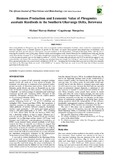Biomass production and economic value of Phragmites australis reedbeds in the Southern Okavango Delta, Botswana

View/
Date
2010-11-10Author
Murray-Hudson, Michael
Mmopelwa, Gagoitseope
Publisher
Global Science Books, www.globalsciencebooks.infoRights
Available under subscription from Global Science Books, APJSBRights holder
Global Science BooksType
Published ArticleMetadata
Show full item recordAbstract
Most work globally on Phragmites spp. has been done in temperate northern hemisphere localities, where winter low temperatures and short day lengths cause a seasonal decrease in growth. In this study, we report above-ground stem length-mass relationships, stem densities and daily growth rates in 3 Phragmites australis reedbeds in the flood-pulsed, tropical Okavango Delta, with the aim of assessing the economic value of this plant, which is widely used throughout north-western Botswana for cladding house walls and fencing yards. Stem density averaged 77 m-2 in 32 plots. Length-mass relationships were best represented by a power curve of the function y = 8.05x1.85, where y is the dry mass in grams, and x is the length in metres (r2 = 0.895). The mean daily growth rate was 0.015 m; and did not appear to vary systematically with season. The maximum standing crop calculated from stem length was 2.89kg/m2, and occurred in May 2005. Annual above-ground production was conservatively estimated at 20-30 t/Ha. Assuming that harvesting takes place not more than once annually, reed beds in the Okavango Delta are worth ~US$45,000/Ha at market. This land use value is over 90 times that of flood recession agriculture in the same area.
Collections
- Research articles (ORI) [270]
